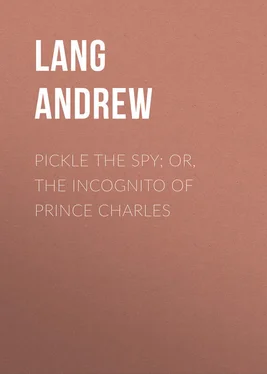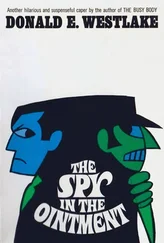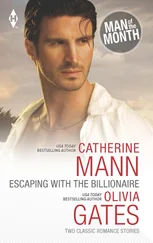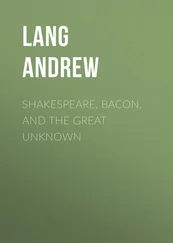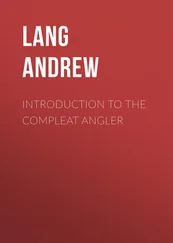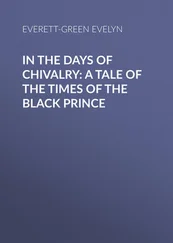Andrew Lang - Pickle the Spy; Or, the Incognito of Prince Charles
Здесь есть возможность читать онлайн «Andrew Lang - Pickle the Spy; Or, the Incognito of Prince Charles» — ознакомительный отрывок электронной книги совершенно бесплатно, а после прочтения отрывка купить полную версию. В некоторых случаях можно слушать аудио, скачать через торрент в формате fb2 и присутствует краткое содержание. Жанр: foreign_antique, foreign_prose, на английском языке. Описание произведения, (предисловие) а так же отзывы посетителей доступны на портале библиотеки ЛибКат.
- Название:Pickle the Spy; Or, the Incognito of Prince Charles
- Автор:
- Жанр:
- Год:неизвестен
- ISBN:нет данных
- Рейтинг книги:4 / 5. Голосов: 1
-
Избранное:Добавить в избранное
- Отзывы:
-
Ваша оценка:
- 80
- 1
- 2
- 3
- 4
- 5
Pickle the Spy; Or, the Incognito of Prince Charles: краткое содержание, описание и аннотация
Предлагаем к чтению аннотацию, описание, краткое содержание или предисловие (зависит от того, что написал сам автор книги «Pickle the Spy; Or, the Incognito of Prince Charles»). Если вы не нашли необходимую информацию о книге — напишите в комментариях, мы постараемся отыскать её.
Pickle the Spy; Or, the Incognito of Prince Charles — читать онлайн ознакомительный отрывок
Ниже представлен текст книги, разбитый по страницам. Система сохранения места последней прочитанной страницы, позволяет с удобством читать онлайн бесплатно книгу «Pickle the Spy; Or, the Incognito of Prince Charles», без необходимости каждый раз заново искать на чём Вы остановились. Поставьте закладку, и сможете в любой момент перейти на страницу, на которой закончили чтение.
Интервал:
Закладка:
Andrew Lang
Pickle the Spy; Or, the Incognito of Prince Charles
‘I knew the Master: on many secret steps of his career
I have an authentic memoir in my hand.’
PREFACE
This woful History began in my study of the Pelham Papers in the Additional Manuscripts of the British Museum. These include the letters of Pickle the Spy and of James Mohr Macgregor. Transcripts of them were sent by me to Mr. Robert Louis Stevenson, for use in a novel, which he did not live to finish. The character of Pickle, indeed, like that of the Master of Ballantrae, is alluring to writers of historical romance. Resisting the temptation to use Pickle as the villain of fiction, I have tried to tell his story with fidelity. The secret, so long kept, of Prince Charles’s incognito, is divulged no less by his own correspondence in the Stuart MSS. than by the letters of Pickle.
For Her Majesty’s gracious permission to read the Stuart Papers in the library of Windsor Castle, and to engrave a miniature of Prince Charles in the Royal collection, I have respectfully to express my sincerest gratitude.
To Mr. Holmes, Her Majesty’s librarian, I owe much kind and valuable aid.
The Pickle Papers, and many despatches in the State Papers, were examined and copied for me by Miss E. A. Ibbs.
In studying the Stuart Papers, I owe much to the aid of Miss Violet Simpson, who has also assisted me by verifying references from many sources.
It would not be easy to mention the numerous correspondents who have helped me, but it were ungrateful to omit acknowledgment of the kindness of Mr. Horatio f. Brown and of Mr. George T. Omond.
I have to thank Mr. Alexander Pelham Trotter for permission to cite the MS. Letter Book of the exiled Chevalier’s secretary, Andrew Lumisden, in Mr. Trotter’s possession.
Miss Macpherson of Cluny kindly gave me a copy of a privately printed Memorial of her celebrated ancestor, and, by Cluny’s kind permission, I have been allowed to see some letters from his charter chest. Apparently, the more important secret papers have perished in the years of turmoil and exile.
This opportunity may be taken for disclaiming any belief in the imputations against Cluny conjecturally hazarded by ‘Newton,’ or Kennedy, in the following pages. The Chief’s destitution in France, after a long period of suffering in Scotland, refutes these suspicions, bred in an atmosphere of jealousy and distrust. Among the relics of the family are none of the objects which Charles, in 1766–1767, found it difficult to obtain from Cluny’s representatives for lack of a proper messenger.
To Sir Arthur Halkett, Bart., of Pitfirrane, I am obliged for a view of Balhaldie’s correspondence with his agent in Scotland.
The Directors of the French Foreign Office Archives courteously permitted Monsieur Léon Pajot to examine, and copy for me, some of the documents in their charge. These, it will be seen, add but little to our information during the years 1749–1766.
I have remarked, in the proper place, that Mr. Murray Rose has already printed some of Pickle’s letters in a newspaper. As Mr. Murray Rose assigned them to James Mohr Macgregor, I await with interest his arguments in favour of this opinion in his promised volume of Essays.
The ornament on the cover of this work is a copy of that with which the volumes of Prince Charles’s own library were impressed. I owe the stamp to the kindness of Miss Warrender of Bruntsfield.
Among printed books, the most serviceable have been Mr. Ewald’s work on Prince Charles, Lord Stanhope’s History, and Dr. Browne’s ‘History of the Highlands and Clans.’ Had Mr. Ewald explored the Stuart Papers and the Memoirs of d’Argenson, Grimm, de Luynes, Barbier, and the Letters of Madame du Deffand (edited by M. de Lescure), with the ‘Political Correspondence of Frederick the Great,’ little would have been left for gleaners in his track.
I must not forget to thank Mr. and Mrs. Bartels for researches in old magazines and journals. Mr. Bartels also examined for me the printed correspondence of Frederick the Great. To the kindness of J. A. Erskine Cunningham, Esq., of Balgownie I owe permission to photograph the portrait of Young Glengarry in his possession.
If I might make a suggestion to historical students of leisure, it is this. The Life of the Old Chevalier (James III.) has never been written, and is well worth writing. My own studies, alas! prove that Prince Charles’s character was incapable of enduring misfortune. His father, less brilliant and less popular, was a very different man, and, I think, has everything to gain from an unprejudiced examination of his career. He has certainly nothing to lose.
Since this work was in type the whole of Bishop Forbes’s MS., The Lyon in Mourning , has been printed for an Historical Society in Scotland. I was unable to consult the MS. for this book, but it contains, I now find, no addition to the facts here set forth.
November 5, 1896.
CHAPTER I
INTRODUCTORY TO PICKLE
Subject of this book – The last rally of Jacobitism hitherto obscure – Nature of the new materials – Information from spies, unpublished Stuart Papers, &c. – The chief spy – Probably known to Sir Walter Scott – ‘Redgauntlet’ cited – ‘Pickle the Spy’ – His position and services – The hidden gold of Loch Arkaig – Consequent treacheries – Character of Pickle – Pickle’s nephew – Pickle’s portrait – Pickle detected and denounced – To no purpose – Historical summary – Incognito of Prince Charles – Plan of this work.
The latest rally of Jacobitism, with its last romance, so faded and so tarnished, has hitherto remained obscure. The facts on which ‘Waverley’ is based are familiar to all the world: those on which ‘Redgauntlet’ rests were but imperfectly known even to Sir Walter Scott. The story of the Forty-five is the tale of Highland loyalty: the story of 1750–1763 is the record of Highland treachery, or rather of the treachery of some Highlanders. That story, now for the first time to be told, is founded on documents never hither to published, or never previously pieced together. The Additional Manuscripts of the British Museum, with relics of the government of Henry Pelham and his brother, the Duke of Newcastle, have yielded their secrets, and given the information of the spies. The Stuart Papers at Windsor (partly published in Browne’s ‘History of the Highland Clans’ and by Lord Stanhope, but mainly virginal of type) fill up the interstices in the Pelham Papers like pieces in a mosaic, and reveal the general design. The letters of British ambassadors at Paris, Dresden, Berlin, Hanover, Leipzig, Florence, St. Petersburg, lend colour and coherence. The political correspondence of Frederick the Great contributes to the effect. A trifle of information comes from the French Foreign Office Archives; French printed ‘Mémoires’ and letters, neglected by previous English writers on the subject, offer some valuable, indeed essential, hints, and illustrate Charles’s relations with the wits and beauties of the reign of Louis XV. By combining information from these and other sources in print, manuscript, and tradition, we reach various results. We can now follow and understand the changes in the singular and wretched development of the character of Prince Charles Edward Stuart. We get a curious view of the manners, and a lurid light on the diplomacy of the middle of the eighteenth century. We go behind the scenes of many conspiracies. Above all, we encounter an extraordinary personage, the great, highborn Highland chief who sold himself as a spy to the English Government.
Читать дальшеИнтервал:
Закладка:
Похожие книги на «Pickle the Spy; Or, the Incognito of Prince Charles»
Представляем Вашему вниманию похожие книги на «Pickle the Spy; Or, the Incognito of Prince Charles» списком для выбора. Мы отобрали схожую по названию и смыслу литературу в надежде предоставить читателям больше вариантов отыскать новые, интересные, ещё непрочитанные произведения.
Обсуждение, отзывы о книге «Pickle the Spy; Or, the Incognito of Prince Charles» и просто собственные мнения читателей. Оставьте ваши комментарии, напишите, что Вы думаете о произведении, его смысле или главных героях. Укажите что конкретно понравилось, а что нет, и почему Вы так считаете.
